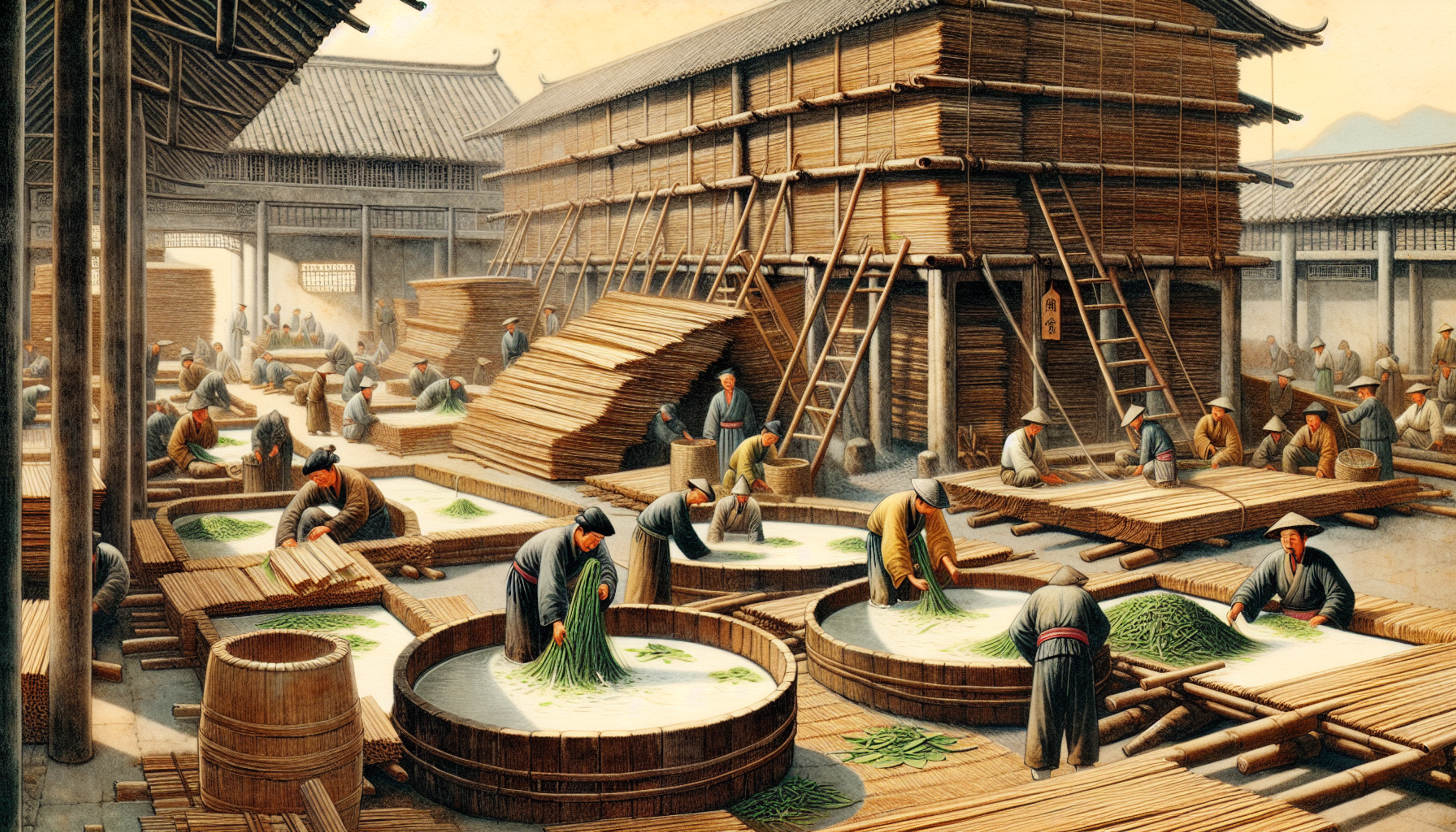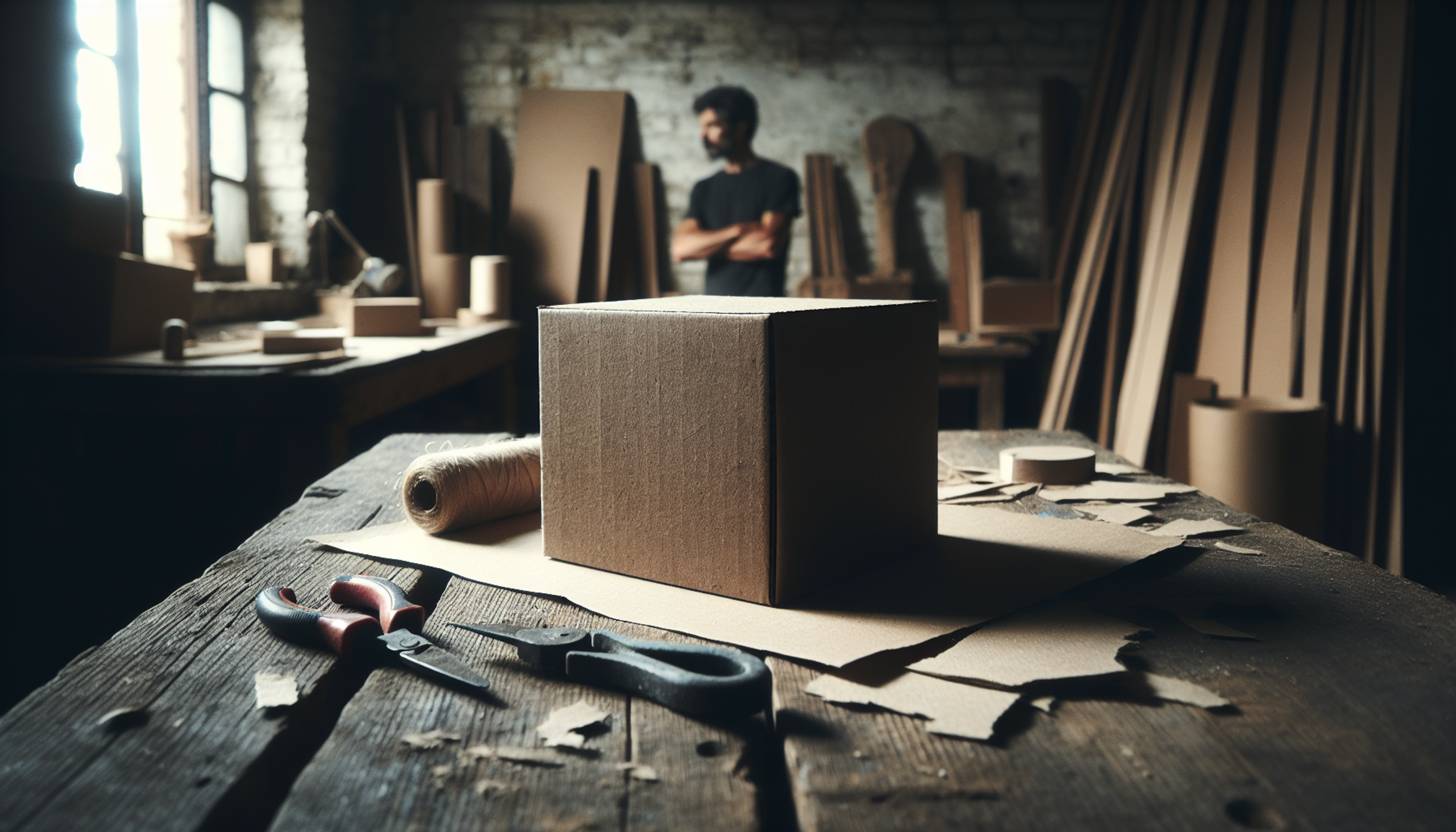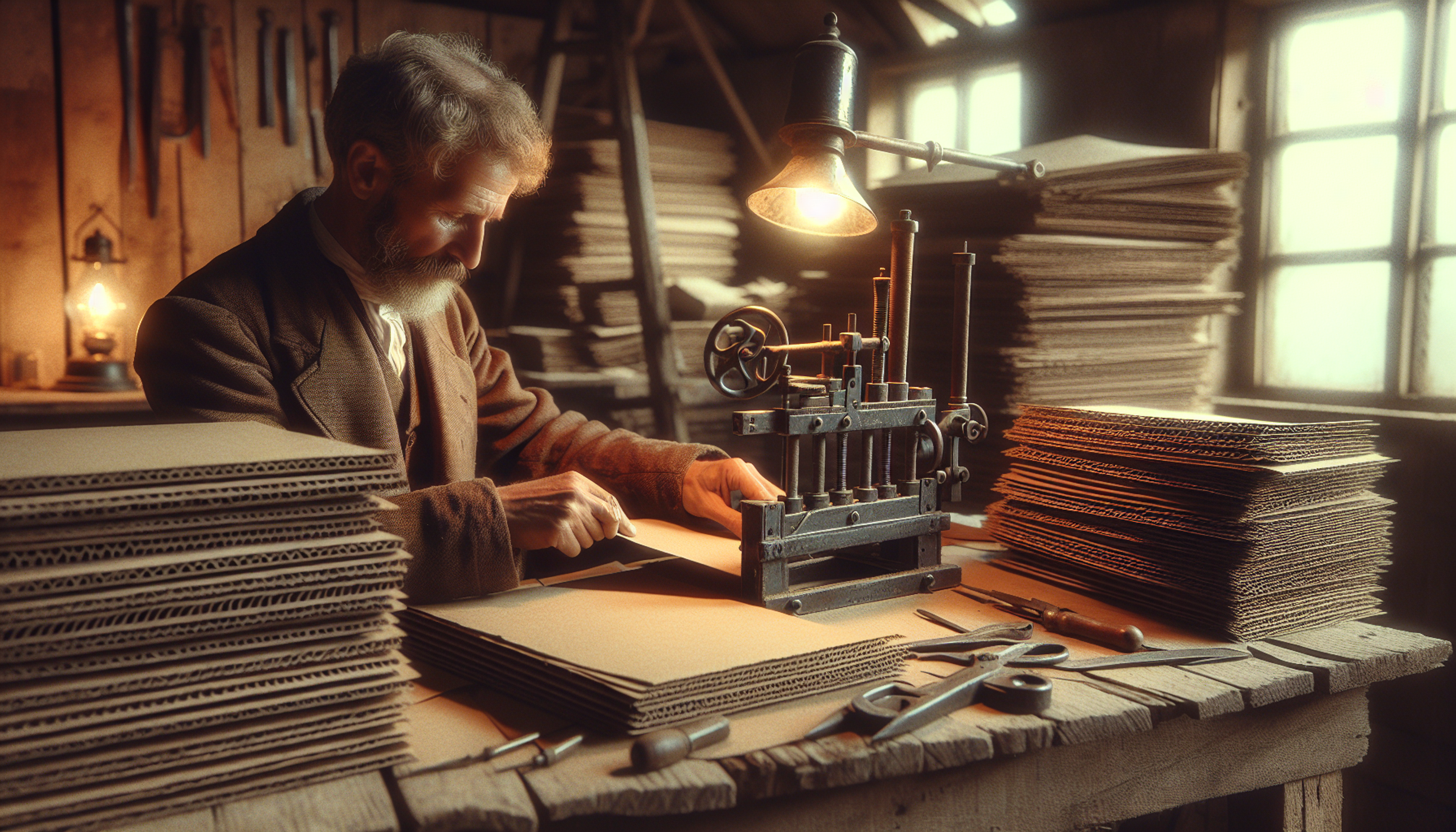Given the fact we're a storage company that sells a variety of storage boxes and packing materials, you'd think we'd know a thing or two about the cardboard box. However, researching for this article, even we were astounded by its historic adventure!
Who would have thought that the unassuming cardboard box, an everyday object that we often take for granted, has such a rich and complex history? From its birth in the bustling markets of 15th-century China to its pivotal role in today’s e-commerce industry, the history of the cardboard box has embarked on a remarkable journey.
As we navigate through its storied past, you’ll discover how this simple yet ingenious creation transformed the packaging world and how its evolution ties into key moments in global history.
Key takeaways
- Cardboard has a long history, beginning in 15th-century China and evolving through numerous innovations such as pleated paper and pre-cut boxes.
- Corrugated cardboard revolutionised the packaging industry with its superior protection & strength, allowing for mass production & assembly of affordable boxes.
- Cardboard is now an integral part of ecommerce due to its adaptability. Sustainability efforts are key to reducing environmental impact by utilizing ecofriendly materials & promoting recycling.
Birth of cardboard – The early innovations

The origin story of cardboard dates back to the 15th century, when artists and traders began experimenting with a paper-based material that had remarkable properties. It was durable yet lightweight, sturdy but flexible. This opened up numerous avenues for innovation in packaging, which would eventually shape its future development. In 19th-century England, M. Treverton & Son patented the very first box made from paperboard, an invention that marks one key point on this journey into modernity. Also during this period, pleated paper (which is similar to corrugated cardboard) received its patent, paving the way for even more innovative applications such as today’s iconic cardboard boxes used widely throughout industry due to their strength and versatility created by both material itself and various forms available within production processes.
Chinese origins
The Tang Dynasty was a time of great prosperity and advances in the Chinese arts, culture, and commerce. It is during this period that they invented cardboard - first as fabric-based packaging during the 1600s, then evolved into paper based material used now.
This early use enabled Innovations such as pre-cut cardboard boxes commonly seen today due to its widespread application all around the globe stemming from China’s advanced papermaking methods.
First paperboard box

1817 saw a major milestone in the history of cardboard when M. Treverton & Son created the first paperboard box to package “The Game of Besieging”, making it one of the earliest uses for this type of packaging.
This was a big step forward and opened doors for progress with regards to how items were packed up and shipped out – leading to increasing development in terms that molded humble cardboard boxes into something more versatile than ever before imagined.
Since then, various sizes have been developed depending on what needs they fulfill while still allowing them to retain their cardboard qualities from long ago all these years later.
Pleated Paper
In the mid-1800s, Edward G. Healy and Allen revealed a significant advancement in cardboard history by attaining a patent for pleated paper, basically wavy material used as liners mostly intended to reinforce tall hats.
This creative design increased strength and stability of this type of paper. Which consequently made it more robust with applications related to packaging objects or freight forwarding activities.
The ability for cardboards such as these to be moulded into new shapes demonstrated its potential use. Than before – opening up opportunities towards developing corrugated boards that could be exploited efficiently across various sectors needing durable materials while still preserving quality information transfer characteristics at the same time…
Robert Gair's accidental discovery – The pre-cut cardboard box

Tracing the development of the cardboard box, we stumble upon a pivotal episode initiated by an unusual twist. In 1879, Robert Gair - a Brooklyn printer and a paper bag maker and producer - was working on orders for seed bags when accidentally his metal ruler shifted as he creased them leading to a revolutionary finding. Prefabricated paperboard boxes could be assembled with one operation after cutting and forming it! This innovation revolutionized packaging processes making production more efficient economically feasible while rendering this humble cardboard container viable & multifaceted- initiating its entry into mass assembly lines thus marking in history.
The happy accident
Gair had a stroke of luck when his metal ruler shifted, cutting through an order of seed bags. Instead of just creasing the bags with it like usual, Gair made an incredible breakthrough and discovered that by using one operation for both cutting and creasing, pre-cut paperboard boxes could be produced.
This momentous revelation was tremendously beneficial to the packaging industry. Introducing prefabricated cardboard boxes allowed packing to become easier and more economical than ever before in history.
The creation of this box represented major progress within its realm as mass production became possible due to this innovation.
Mass production and assembly
The invention of the pre-cut corrugated cardboard box manufactured by Gair had a major impact on the packaging industry. Thanks to it being able to be mass produced, stored flat and easily put together quickly, these boxes became accessible and affordable for businesses around the world.
This led to corrugated paper shipping cartons replacing wooden crates as well as other forms of packing during the early 20th century, which signified great changes in this field with cardboard becoming an essential element within its structure.
The kick start was provided by his discovery of what is known today as “the first corrugated cardboard box”.
Corrugated cardboard – A packaging revolution

Cardboard boxes and corrugated cardboard are a revolutionary type of paper product that have made an impact on the packaging industry. This material consists of two or more layers of paper with ridges in between for increased strength and flexibility, making it perfect for use as corrugated cardboard shipping boxes.
Corrugated boxboard was first patented by Albert S. Jones in England back in 1856, to be used initially primarily as wrapping bottles. Its original purpose evolved over time until it was widely adopted from 1900 onwards.
It later became a mainstay shipping container material we now know today due to glass lantern chimneys’ usage alongside other products such as corrugate paper earlier on during its lifetime too.
The birth of corrugated cardboard
In 1871, Albert S. Jones from New York City invented a type of board called corrugated cardboard that was intended for the purpose of wrapping bottles and glass lantern chimneys prior to them being transported.
This single-sided corrugated board patented by him came with unique properties over other methods used at the time when it comes to packaging solutions as it offered added protection and strength in comparison to other methods.
This discovery revolutionised shipping practices since then, as utilising these materials became essential within businesses focused on distributing goods.
Ushering in an era filled with enhanced safety measures during transit processes thanks to its cushioning capabilities on top of raw material construction such as more robust cardboards which ultimately opened up wider opportunities due largely to his innovative ideas.
Oliver Long's Improvements
Corrugated cardboard boxes, the invention of Oliver Long and an improvement on Jones’ original version, revolutionized the packaging industry. He added liner sheets to both sides of the material for increased strength and durability making it better suitable for transporting goods, thus giving us a more reliable cardboard box today.
This advancement made a great difference in corrugated boxes’ qualities compared with that before, as this layering addition provided additional protection against impacts while maintaining its lightness at once.
Cardboard boxes go mainstream – Adoption by cereal companies
As the 20th century came into full swing, cardboard boxes were utilised for increasingly more than just shipping goods. This transition was largely steered by cereal manufacturers such as Kellogg’s who recognized their utility in cost-effective and adaptable packaging solutions.
This represented a remarkable change in food industry packaging practices with companies like those of cereals being some of the first to use cartons made out of humble yet versatile cardboard material, thus establishing another significant step forward for this particular type of box which had become so popular worldwide over time.
Kellogg's innovations
Kellogg’s, a renowned cereal manufacturer, pioneered the widespread use of cardboard boxes. Through their utilization of NaviLens technology in packaging and investigation into fiber-based alternatives for recycling purposes.
They have effectively transformed how these containers are perceived, from being nothing more than utilitarian items to functioning as an integral part of brand visibility strategies.
By leveraging such advantages offered by printing on boxes. Kellogg’s was able to create impressive branding techniques that showcased its products with strong visual appeal – ushering in a completely new era with respect to cardboard use altogether.
The rise of cardboard in the food industry
The fact that cereal companies began to use cardboard boxes ushered in a paradigm shift for other businesses within the food industry. As more and more entities joined this trend, it became common practice to employ cardboard as a packing solution. Today, over half of all corrugated material produced each year is used specifically for such purposes.
This widespread embrace of its versatility, durability and affordability demonstrates how integral these containers are when transporting delicate goods across great distances or preserving perishable items — an impressive outcome given the long history associated with using cardboard boxes!
Cardboard boxes and E-commerce – A modern love story
As the 21st century progresses, an amazing synergy between cardboard boxes and e-commerce becomes increasingly evident. The tremendous growth of online shopping has made cardboard packaging a hot commodity, and producing large quantities of these containers are utilised on a daily basis to deliver products all over the world. In 2023, the Cardboard Box & Container Manufacturing industry was valued at an astounding $82.8bn.
This strong relationship is a testament to just how adaptive and versatile the humble box can be. In its earliest forms, it was nothing more than a crudely constructed package, yet with time it has morphed into an integral part of global web stores providing customers with items they need at their doorstep within days or even hours!
The growth of online shopping
The popularity of online shopping has been extraordinary, with 27% of the global population using it to purchase items. This surge in demand for goods purchased over the internet has sparked an increased need for cardboard boxes as a reliable and cost-effective form of packaging.
As businesses seek ways to improve their customer service, they also seek ways to improve their customer service. They are adapting design elements within these humble boxes. Showing its adaptability by creating innovative solutions that maintain product security while also boosting brand recognition.
The remarkable development seen in cardboard box packaging designs is yet another reflection on just how powerful and versatile cardboards can be.
Innovative packaging solutions
The development of sustainable cardboard packaging solutions has been an important response to the increasing growth in e-commerce. These new and innovative options include biodegradable packing peanuts, recycled plastic wrapping and reusable containers, all allowing for consumer concerns about ecofriendliness to be addressed while meeting specific online merchant needs.
To Support this initiative, humble cardboard boxes which are made from both paper and card have become extremely popular due to their ability diminish environmental impact associated with electronic retailing significantly without compromising reliability or style.
Sustainability and recycling – The importance of responsible cardboard use

The use of cardboard boxes must be done with sustainability and recycling in mind. The awareness for the environment has heightened, resulting in a higher demand to adopt eco-friendly practices when handling materials like these. This focus on responsible usage is present across industries including food production and e-commerce business sectors.
Cardboard material comes from trees or plants that have been harvested or through recycled wood scraps such as chips or shavings. Thus making their sustainability an essential factor impacting its environmental effectivity significantly lower than other products used regularly today.
By using ecological resources wisely, we are able to ensure better management with regards to proper utilization while keeping waste output minimal at the same time, key components for being more green friendly during this modern era altogether.
Cardboard Materials
Manufacturers create cardboard from raw materials that come from responsibly-managed forests such as timber, pulp and wood chips. Not only does this minimize waste by allowing for reuse of paper products, but it also conserves natural resources, which is beneficial to the environment.
Top brands like Dell, Adidas, Nike, Patagonia, Garnier WeWood Kelloggs and Paper Mart are leading in using recycled material for their boxes instead of creating new ones, exemplifying a more sustainable approach towards production processes.
Ultimately these moves contribute to creating a greener future with less environmental impact on our planet through responsible practices involving cardboard boxes made out of recyclable sources rather than virgin pulp or other processed woods.
Recycling efforts
Recycling is key to the efficient and sustainable use of cardboard boxes, which are among the most utilised forms of packaging materials worldwide. This process prevents excessive consumption of raw resources and works towards reducing pollution levels by reusing waste materials. In order for this practice to be successful, there must firstly be a collection phase before sorting begins.
Following that shredding, pulping, filtering, and then conversion happens in turn creating new cardboard containers from old ones, thus protecting natural resources without compromising quality products or quantity production.
A greater understanding has developed about our environment over time, thus requiring recycling initiatives if we desire an eco-friendly future involving cardboard packing solutions as well as others alike.
Boxed-up and ready to go!
From its meager origin in 15th century China to the pivotal role it plays in today’s e-commerce industry, the cardboard box has experienced an incredible trajectory. What started out as a simple packaging solution later progressed into a flexible and changeable tool which gave rise to new strategies for packaging industries all over the world.
Its invention was merely circumstantial. With innovations from cereal businesses and shoppers shifting online by demand, each milestone on this journey of the humble cardboard container adds more depth not only towards its history but also how far technology has come since then. With no end ahead, one thing is definite: cardboards will continue to transform itself and imprint our lives everlastingly!
HOLD Self Storage is here for you
For more info, check out our guide for useful tips and tricks to packing boxes.We also have a fantastic box shop where we sell a range of affordable packing materials.
If you're looking for innovative, household or business storage options in the London area, get an offer from HOLD today.
Frequently Asked Questions
What is the history of cardboard boxes?
The history of cardboard boxes can be traced back to the 15th century China. A few centuries later, M. Treverton & Son invented the first one in 1817 and then Robert Gair created a pre-cut version in 1879. Cardboard has been used for all kinds of purposes ever since, as these lightweight yet robust containers have come to play an integral role across many sectors due to their practicality and cost effectiveness.
What was the original purpose of cardboard?
Since its invention by French silk manufacturers in 1840 to safely transport the Bombyx mori moth and eggs, cardboard has grown into an economically sound option for packing various commodities like household items, breakfast cereals, retail shipments, as well as other products.
Did you know facts about cardboard?
Cardboard boxes are an amazing resource for being both eco-friendly and renewable, did you know that the very first one was invented back in 1817? Unbelievably, this incredibly versatile material can be used to make incredible items such as a colossal 22,000 pound box!
When was cardboard first invented?
Cardboard was invented in the 15th century by Chinese engineers. In the UK this inspired a paper box that in 1817 was created by English company Treverton & Sons. Robert Gair in Scotland in 1879 introduced precut cardboard boxes.
Who invented the pre-cut cardboard box?
In 1890, Robert Gair revolutionized the packaging industry with his invention of a pre-cut cardboard box. His innovation enabled greater efficiency and cost savings in manufacturing products using his innovation.


